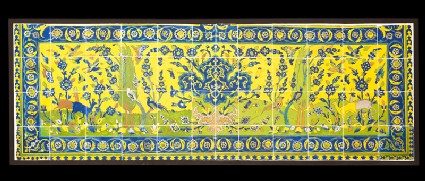Browse: 10610 objects
- Reference URL
Actions
Set of forty-eight tiles displaying birds and animals in a landscape
-
Description
In the Iranian world, the use of tiles in architectural decoration dates back to pre-Islamic times. Decorated with a range of techniques including underglaze and overglaze painting, tiles had practical, aesthetic and broader cultural implications. While providing a protective barrier to otherwise perishable brick constructions, tile coverings spoke about a building’s function as much as about the social status, wealth and aspirations of its patron.
This panel, decorated with the cuerda seca technique, can be dated to the mid-17th century when elaborate tile compositions were made to decorate garden pavilions and palaces in Iran, especially in Isfahan, then capital of the Safavid empire (1501-1736). Scenes of garden entertainment and hunting, found in examples that have survived in museum collections, provide a window on the luxurious lifestyles of early modern Iran. In this particular example, the decoration does not include human figures but depicts a verdant garden inhabited by animals and birds. These are arranged in symmetrical fashion either side of a central lobed motif.
The technique known as cuerda seca (literally ‘dry cord’) was meant to reproduce the effect of tile mosaic without its time-consuming process. Various glazes were applied to the ceramic surface separated by thin lines of a greasy, manganese-based, substance. With firing, this compound would disappear, leaving neat dark outlines around the different areas of colour.
-
Details
- Associated place
- Date
-
17th century (1601 - 1700)
Safavid Period (1501 - 1722)
- Material and technique
- fritware, with decoration in coloured glazes applied in the cuerda seca technique
- Dimensions
-
with frame 101 x 278 x 5.5 cm (height x width x depth)
without frame 93 x 269 cm (height x width)
each tile 24 x 15 cm approx. (height x width)
- Material index
- Technique index
- Object type index
- No. of items
- 48
- Credit line
- Purchased, 1979.
- Accession no.
- EA1979.16
Glossary
fritware
-
fritware
Ceramic material composed of ground quartz and small quantities of clay and finely ground frit (frit is obtained by pouring molten glass into water).
Location
Objects are sometimes moved to a different location. Our object location data is usually updated on a monthly basis. Contact the Jameel Study Centre if you are planning to visit the museum to see a particular object on display, or would like to arrange an appointment to see an object in our reserve collections.
Galleries
© 2013 University of Oxford - Ashmolean Museum



